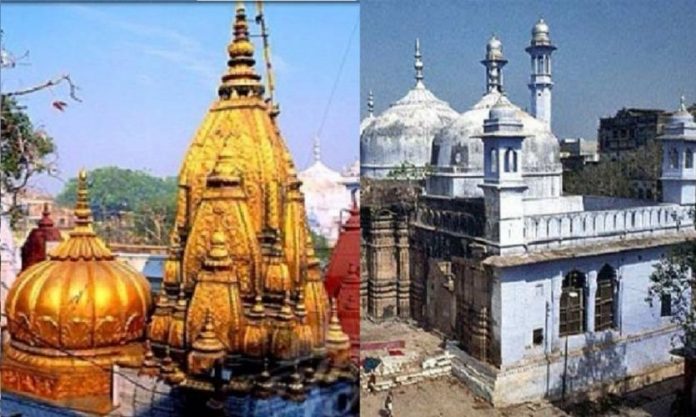By Siddhant Mohan, TwoCircles.net
Several citizens of Varanasi, the Loksabha constituency of Narendra Modi, and activists in the region fear and sense that the Uttar Pradesh government is planning to repeat the 1992 Babri Masjid episode by expanding the compound of ancient Vishwanath Temple of Varanasi.
The ancient Vishwanath temple — which has been demolished and rebuilt many times — was last demolished by Aurangzeb in 1669 CE, who built Gyanvapi mosque at the runis of the temple. After several failed attempts to rebuild the temple by demolishing the newly built mosque, it was Ahilyabai Holkar who constructed a new temple adjacent to the mosque in 1780.
But since the demolition of the Babri Masjid, the mosque and the temple both have landed in conflict at several times in the History. Chief Minister Yogi Adityanath proposed an expansion of the Temple corridor and revealed his plan to connect the temple directly with the Ganga river, which flows about half a kilometre from the Temple. The plan, which was originally introduced in 2009 by the then state government but was later withdrawn, demands the acquisition and demolition of 167 houses at a length of 450-metres in order to connect the temple and the Ganga.
The plan, which has been facing numerous protests since its inaction, almost puts Gyanvapi Mosque devoid of any residential support, thus “more vulnerable to threats and nationalist politics,” says Sunil Kumar Jaiswal, a 45-year-old cosmetics seller near the temple.
Jaiswal said, “When you build a compound of about half a kilometre around a temple in conflict with a mosque, it is easy to figure out what you are planning to do.” Jaiswal said that he does not think the government may take a step “identical to 1992”, but this is apparently going to put the mosque and the devotees in danger.
Sanjeev Kumar, a leader of Aam Aadmi Party, told TwoCircles.net, “The thing here is that the state has proposed and enacted a plan, but it does not look like that the plan belongs to the government. It feels that the plan particularly belongs to Bharatiya Janata Party and its Hindu nationalist agenda.”
Varanasi’s newspapers are filled almost every day with the stories about the proposed plans with two conflicting stories placed side by side. The district administration has been saying for long that no houses and homes would be demolished without consent, but alongside the same, half a dozen houses have already been demolished and rest have been marked with red paint for further action. Sanjeev said, “If the government continues to show a two-faced nature, how can one not think that religious freedom of a particular sect is at stake?”
Not only Sanjeev, many others in the area have raised the same concern. A theatre artist, who lives in the same area, said on the condition of anonymity, “I do not have any problem with demolishing a mosque or rebuilding it again. But here, people are lying to us. The government is giving us false notions that it wants to restore the old Temple, but we all know where the old Temple was. So if it wants to restore the old Temple, what action it could take to do the same?”
“I see a big compound where hundreds of Karsevaks could fill in, and that is not the projected purpose of the Temple,” he added.
The eagerness of UP government can be understood with the fact that Yogi Adityanath himself has been monitoring the project, and he conducts a meeting with officials during his every visit to Varanasi. In fact, such has been the eagerness of Yogi Adityanath in this issue that a veteran journalist from the area threatened with committing suicide if the demolitions went ahead as planned.
“The Hindutva current is strong in Varanasi, and we think that government is taking advantage of the same. But many people are not able to understand the situation… they are just trying to save the heritage and their houses,” said Lalta Prasad, a 76-year-old resident of the Bansfatak area, where the Temple gate is situated.
Prasad further said, “And I hope they don’t get the chance to understand it and that the protests continue like now. My fear is that if they will understand the real issue, they may happily give away their houses to another apparently violent episode.”
The protest by the residents is gathering pace in city and various political parties are pouring in to extend their support to the protestors. Prajanath Sharma, district president at Indian National Congress, did not admit to the rumours and speculations, but said that the “now the people living there are facing their worst fears”.
Just a few days back, Waseem Rizvi, the Chairman at UP Shia Waqf Board, asked the Sunni Waqf Board and concerned authorities to “happily give up” the mosques which were built by demolishing temples, not to the surprise, Gyanvapi mosque was counted in his list.
The BJP-led state government may take political advantage by expanding the temple, and many believe that it will be harsh to assume that the state will back or moderate ‘activities’ like that of 1992. But a new fear may settle in when a mosque will be out alone in the open compound which will probably be filled with the saffron-clad cars and vehicles of top leaders of the Yogi and Modi government.


